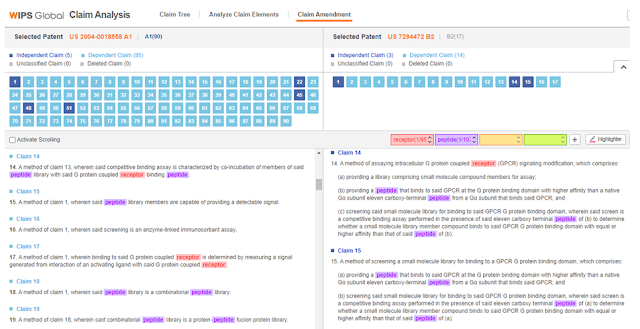Patent literature consists of a bibliography, summary, description of the invention, claims, drawings and other many elements. Among them, the scope of claims serves to establish the scope of protection of patented inventions with the technical contents to be exclusively entitled. In other words, since the scope of a patent right is determined by the claims, the technology to be protected must be stated in the claims. If it is described only in the description of the invention and not in the claims, it cannot be protected by patent rights. Claims are the most important item in an application because the whether the patent is granted or not is determined by the content of the invention described in the claims, and it is also the most essential part in the search/analysis process to determine registration possibility, infringement, invalidity, etc. Therefore, it is very important to analyze the claims to understand the technology of the patent when reviewing.
However, it is not easy to clearly understand the protection scope of the invention because the claims are composed of complex citation relationships such as independent claims or dependent claims. Furthermore, the language of each country and the way claims are written differs, making it more difficult to analyze the entire claims.
To help with these difficulties, WIPS Global provides a ‘Claim Analysis’ feature that enables more efficient review by analyzing the claim tree and visualizing the comparison according to publication/registration of documents. Let's take a look at it now.
 |
| wipsglobal.com> View Details |
Claim analysis can be entered through the View Details.
 |
| wipsglobal.com> View Details> Claim analysis |
Considering that claims are mostly composed of multiple terms and that they can change depending on the status of the literature, WIPS Global's Claim Analysis provides a claim analysis module to enhance the identification. The figure above is a claim tree (hierarchy analysis). Using claim tree, you can see the independent claim-dependent claim structure and single/multiple reference relationships essential for checking the scope of rights. Each number represents a claim number.
When a claim
is selected, the reference relationship of the selected claim is displayed as a
red line. A rectangular border is a group of claims that refer to the same
claim within the same depth. If you mouse over a claim number displays the
claims it refers to. Unclassified claims are indicated separately, which means
that independent or dependent claims cannot be mechanically distinguished.
 |
| wipsglobal.com> View Details> Claim analysis |
At the bottom of the claim tree, the content of the selected claim and the claims it references are displayed together.
 |
| wipsglobal.com> View Details> Claim analysis |
‘Analyze claim elements’ allows you to more easily interpret and leave a note about the important parts while reviewing elements of the each claim. Click on Claims at the top to display the contents on the left. You can edit the text by dragging it into the space to the right, and you can type a note right next to it.
 |
| wipsglobal.com> View Details> Claim analysis |
‘Claim Amendment’ allows you to compare the documents before/after grant. If you select a claim number from the claim list at the top, you can compare and analyze the content of the claims deleted or amended during the examination process. The left side is published status and the right side is the claim of the granted document. In the picture above, you can see that dependent claims No. 14 and 15 were amended into independent claims during the examination process. You can also mark key keywords using a highlighter.
So far, we have looked at WIPS Global's Claim Analysis. With WIPS Global’s various analysis features, prevent errors in understanding patented technologies and check the scope of rights more easily and quickly!


No comments:
Post a Comment